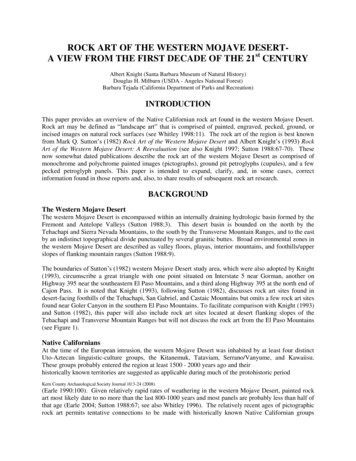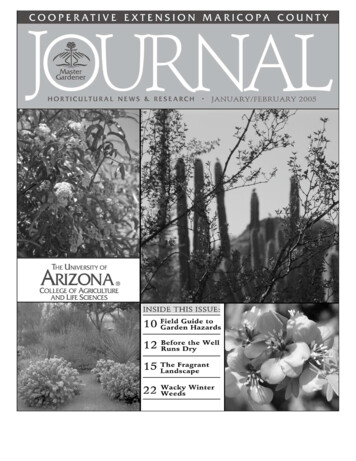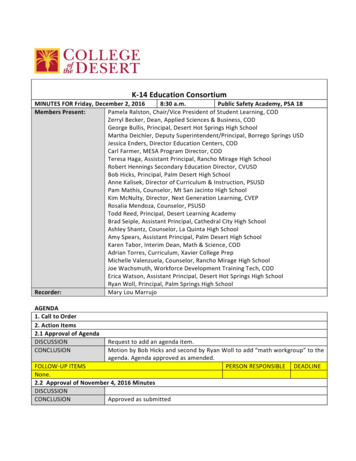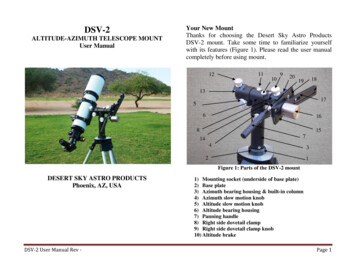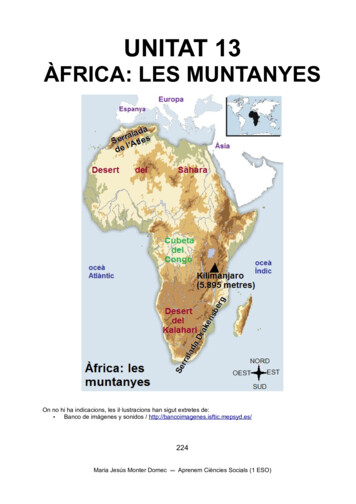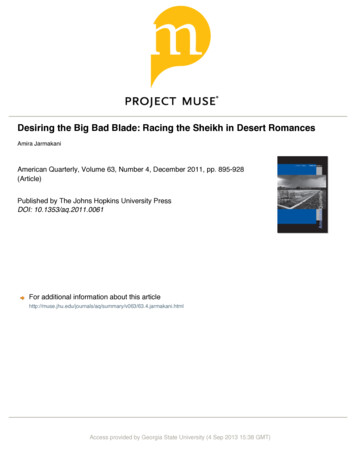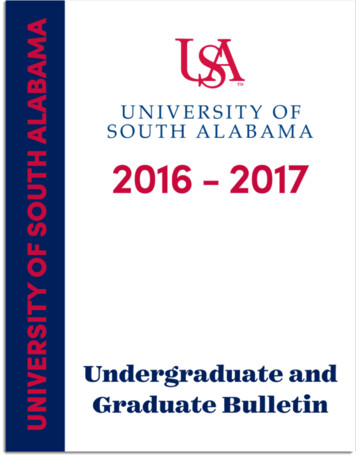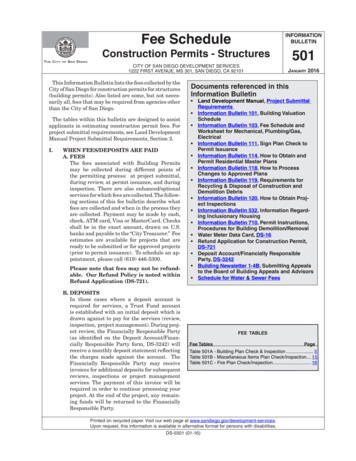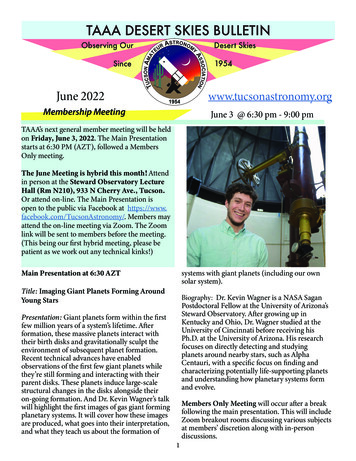
Transcription
TAAA DESERT SKIES BULLETINObserving OurDesert Skies1954SinceJune 2022www.tucsonastronomy.orgMembership MeetingJune 3 @ 6:30 pm - 9:00 pmTAAA’s next general member meeting will be heldon Friday, June 3, 2022. The Main Presentationstarts at 6:30 PM (AZT), followed a MembersOnly meeting.The June Meeting is hybrid this month! Attendin person at the Steward Observatory LectureHall (Rm N210), 933 N Cherry Ave., Tucson.Or attend on-line. The Main Presentation isopen to the public via Facebook at https://www.facebook.com/TucsonAstronomy/. Members mayattend the on-line meeting via Zoom. The Zoomlink will be sent to members before the meeting.(This being our first hybrid meeting, please bepatient as we work out any technical kinks!)Main Presentation at 6:30 AZTsystems with giant planets (including our ownsolar system).Title: Imaging Giant Planets Forming AroundYoung StarsBiography: Dr. Kevin Wagner is a NASA SaganPostdoctoral Fellow at the University of Arizona’sSteward Observatory. After growing up inKentucky and Ohio, Dr. Wagner studied at theUniversity of Cincinnati before receiving hisPh.D. at the University of Arizona. His researchfocuses on directly detecting and studyingplanets around nearby stars, such as AlphaCentauri, with a specific focus on finding andcharacterizing potentially life-supporting planetsand understanding how planetary systems formand evolve.Presentation: Giant planets form within the firstfew million years of a system’s lifetime. Afterformation, these massive planets interact withtheir birth disks and gravitationally sculpt theenvironment of subsequent planet formation.Recent technical advances have enabledobservations of the first few giant planets whilethey’re still forming and interacting with theirparent disks. These planets induce large-scalestructural changes in the disks alongside theiron-going formation. And Dr. Kevin Wagner’s talkwill highlight the first images of gas giant formingplanetary systems. It will cover how these imagesare produced, what goes into their interpretation,and what they teach us about the formation of1Members Only Meeting will occur after a breakfollowing the main presentation. This will includeZoom breakout rooms discussing various subjectsat members’ discretion along with in-persondiscussions.
Notes From The Presidentby Mae SmithMay 2022Treasurer. She will know the amount of fundingthat will be recommended to the new Boardfor your TAAA area in 2022-23. If you wish tomake suggestions for changes you are welcometo do so.One of our largest and most fun events wasthe May 15th lunar eclipse star party on theUniversity of Arizona Mall.At the May regular Board meeting:1) Some discussion was held of possibleupcoming projects at CAC.2) A report was given by David Levy of the newYouth Program he is setting up. If you have anyreferrals of possible youth participants, pleasepass them on to David.3) The need to establish a TAAA PropertyDonation Manager position description andchange from having these duties absorbed intovarious Board positions was agreed upon.4) Funding for new software for the Treasurerand for an increase of funding to match currentprices for the Grand Canyon Star Party wereapproved.Watching the eclipse was incredible, but aspecial element of joy was all the wonderfulpeople who joined us on the mall, lookingthrough telescopes, talking with our TAAAmembers, and having a really relaxed, fun,family experience. We had telescopes on thegrass, but also participated in the FlandrauPlanetarium events with a delightful (anddelicious) Oreo moon activity. Reasonableestimates for attendance at this event wereat least 700 participants!! We were there forhours and left tired, but very happy for such arelaxing experience that added to our repertoireof delightful, shared TAAA memories.The TAAA held three board meetings in May.The regular May 11th meeting mostly focusedon developing a possible budget for the 20222023 year. A tentative budget was approvedto be passed to the New Board at the Junemeeting when the New Board will finalize abudget for the upcoming year. There were somerecommended changes from last year, mostlyfocusing on anticipated increased expensesand anticipated TAAA activities and projectsduring the next year. Leaders may address anyquestions regarding their funding requests fornext year to Barbara Whitehead, our incomingIn May the TAAA Board held two additionalBoard meetings in an effort to arrive ata successful new construction contractarrangement with a different company forcompletion of the interiors of the two new CACbuildings. The Board approved a contract thatappears to conform to the requirements witha new contractor. The contract is currently inprocess of being printed and signed by bothparties.President Mae SmithTAAA Desert Skies BulletinDavid Rossetter – EditorTerri Lappin & Jim Knoll - ProofreadingGreg Ruppel -Images;Ken Bertschy - Graphics2
School/Public Star Party RequestsJune 2022by Jim KnollThank you for volunteering your time and talents for our extremely important outreach mission. Below is the list for Juneand early July, 2022. We are starting to wind down our events before the Monsoon break. If you are new to Star Partyoutreach, let me know and we’ll be sure to help you get started. It is important you sign up for star parties if you plan toattend, whether you bring a scope or help in other ways, so I can manage who from TAAA will be on-site and for you tobe included in any reminder or weather emails.The PUBLIC Astronomy Events are also listed on the TAAA (tucsonastronomy.org) and Night Sky Network (NSN)(nightsky.jpl.nasa.gov) calendars. Also, all PUBLIC star parties will be listed on the TAAA Facebook events page and willbe updated based on weather, etc. in real-time. You can follow any of those events and get a notification when I updatethe event. Again, this is only for PUBLIC star parties listed on Facebook.Contact Jim KnollJUNE[continued]Age/Grade Level: Kids ages 5 - 12# Participants: 152 Scopes Needed (1 SOLAR, 1 DAYTIME MOON)Setup Time: Noon. Start: 1 pm. End: 2 pm.Nearest Moon Phase: between New and First QuarterDirections: Sunrise/Swan. West on Sunrise pastHacienda Del Sol. Left on Via Palomita. Right at stopsign into resort.Viewing Location: TBDSaturday June 4 -- SE TUCSONSycamore Canyon HOA17362 S Rustling Leaf TrailAge/Grade Level: All Ages# Participants: 752 Additional Scopes Needed (Kevin Bays scheduled)Setup Time: 7:30 pm. Start: 8 pm. End: 10 pm.Nearest Moon Phase: First QuarterDirections: Houghton Rd / Sahuarita. West onSahuarita. Left (south) on Harrison. Harrisonbecomes Sycamore Leaf. Take 5th right onto RustlingLeaf. Park is 1st & 2nd lefts.Viewing Location: Sycamore Canyon ParkFriday June 10 -- SOUTH TUCSON (SOLAR)Pueblo High School3500 S 12th AveAge/Grade Level: All Ages# Participants: 752 SOLAR Scopes NeededSetup Time: 7:00 AM. Start Time: 8 AM. EndTime: 12 NOON.Nearest Moon Phase: N/ADirections: SW Corner of 12th Ave and 44th St.South on 12th Ave and take first right to enter primaryparking lot.Viewing Location: Courtyard (about 50 yards fromParking Lot)JULY Friday July 1 -- NORTH CENTRAL TUCSON(DAYTIME SOLAR/MOON)La Paloma Resort Kids Club3800 E Sunrise Dr, 85718Monday July 18 (ORACLE)Biosphere 22 telescopes for about 15 participantsSetup Time: 7:15 pm. Start: 8 pm. End: 10 pmMETEOR SHOWER3There is a POTENTIAL of a short but intensemeteor shower Monday May 30th from 10 - 10:30pm Tucson Time. The Earth may pass through theremnants of comet 73P/Schwassmann-Wachmann3(SW3). The shower is called the Tau Herculids. Thiswill be an all or nothing event. If the debris from SW3was traveling more than 220 MPH when it separatedfrom the comet, we might see a nice intense meteorshower. If the debris had slower ejection speeds, thennothing will make it to Earth and there will be nometers from this comet. For more information, checkout: lid-meteors-may-intense-shower/We will be hosting a couple professional astronomersat CAC (we are one of three sites they will use) forthis event as they set up their camera equipment tohopefully image and triangulate some meteors thatevening.
Connecting Astronomy with the Publicby Jim KnollPrograms in May are starting to wind down as schools begin their summer break and theresorts enter their off-peak season. We had 9 public/schooland 6 Tucson Stargazing Adventures (TSA) events. For bothprograms, we deployed 46 telescopes for 48 hours with 19different volunteersproviding a total of 162volunteer hours. Weprovided astronomyeducation to about 1315participants. Our events thismonth included six schools(Wrightston Ridge,The Proud Astronomers (Esperanza)Esperanza Elementary,Safford K-8, Gridley MiddleSchool, Desert Christian High School, and Casas Christianschool), the Lunar Eclipse on the UA Mall (had over 500 atthis one), Agua Caliente Park, and Catalina State Park. OnEsperanza Elementary Schoolthe TSA side, we supported three resorts, a homeownersassociation (will be doing this monthly), a private business,and a private group at an Air B&B.Total Lunar Eclipse at the University of Arizona MallJune is pretty quite right now. We have one school, one HOA, one Library, and two TSA events.Many members will be heading to the Grand Canyon for the annual Star Party from June 18 –25. We expect to have on average around 50-60 telescopes each night with around 1,500participants nightly. If you haven’t volunteered for the GCSP, you should try it. The skies areincredibly dark at 7,000 feet and the participants are extrememly friendly and excited to lookthrough the telescopes. We normally have participants from all over the world attending.We will be taking a Monsoon break over the summer. I am sure we will have a few events, butwill not pick back up in earnest until September. Hopefully everyone has a great summer andour Monsoon is an ACTIVE ONE!!4
Other TAAA NewsTAAA Election 2022 ResultsThe NVRC ran the TAAA Leadership Election before and during the May 7, 2022 General MembershipMeeting using OpaVote. Below are the results:President (1-year):Mae SmithNVRC - 1 year:Peter (Pete) J. HermesVice President (1-year):Doug SmithNVRC - 2 year:David PassSecretary (2-year):Robert ReynoldsJohn ChristensenTreasurer (2-year):Barbara WhiteheadMAL - 1 year:Gus GomezMAL - 2 year:John KalasDavid RossetterThe new board and NVRC members will take their positions on June 1, 2022.The raw results files from OpaVote were submitted to the TAAA Secretary.As always, please contact the NVRC if you have any questions.David Rossetter - Chair, John Christensen, Allen ForceBook Of the MonthThe Glass Universe by Dava SobelReview by Douglas SmithThis is a wonderful book to read. It documents the little known story of the women of the HarvardObservatory and the landmark discoveries they made that laid the foundations for modern astronomy.The book describes the key women, their careers and personal lives and their struggles in a field thatwas, up until then, very male dominated. Much of the information comes from letters and other firsthand documentation. These women started out working for Edward Pickering on the mundane job tomeasure brightness and position of stars from the glass photo plates taken at Harvard Observatory. Someof these women had no formal education. The book documents how they made their discoveries fromthis basic work. Many of these women would go on to spectacular careers in astronomy and famousuniversities all around the world. I highly recommend this book as a good read. It is an absolute mustread for the student in the history of Astronomy. Dava Sobel is the same author who authored the NewYork Times bestseller ‘Longitude’. She also authored ‘Galileo’s Daughter’.Astronomical League Workshop open for enrollment.Place: Woods Memorial Library, 3455 N First Ave., TucsonDate: Saturday August 20, 2022Time: 10 AM until NoonSynopsis: This workshop is designed for anyone who may beinterested in pursuing one of the Astronomical League observingprograms for the first time or anyone in interesting in learning aboutthese observing programs. The workshop will cover how the variousobserving programs work, program requirements, selection of appropriate program, recommendedequipment, resources, logging requirements, and much more.If interested you can contact the TAAA Astronomical League Correspondent (ALCOR) at theinformation below or sign up using the sign up sheet that will be available at the June, July and AugustGeneral Member meetings. Please note the workshop is limited to 20 people.TAAA ALCOR: Douglas Smith; 520-396-32335
Special Interests GroupsThe Starry Messengers SIG will take a break over the summer,so our next meeting will be on September 12th. Over thesummer, we will continue to have outreach events includingsome in conjunction with the release of the highly anticipatedfirst science images from the James Webb Space Telescope! Wehope to have an event on or about July 23rd, so watch youremail.If you want to become involved in astronomy outreach withthe TAAA, send your email address to Terri Lappin so you can be added to the SMSIG email list.SMSIG on the WebAstronomy Fundamentals SIGby Connor JusticeCome join us for a presentation from the fundamentals of amateur astronomy. Learn your wayaround the night sky to add to your observing enjoyment. Meetings are on the second Thursdayof each month.The next meeting is on Thursday, June 9th at 6:30 pm - 8:00 pm. Topics to be determined.Contact Conner Justice for Zoom link and more information.AFSIG on the WebAccess videos of previous meetings through the Members Only section of the TAAA web site.6
TAAA Ladies’ Night Outby Susan O’ConnerLadies’ Night Out is a social interest group for women members of the club.The group meets once a month at a local restaurant for fellowship andconversation.If you are interested in Ladies’ Night Out, please contact Susan O’ConnorJune Ladies Night OutThursday, June 16, 6:30pmBlue Willow2616 North Campbell Ave(East side of Campbell between Copper and Glenn )Preview the menu at bluewillowtucson.comRSVP SusanAstro-Imaging SIGby Gregg RuppelThe next AISIG meeting is Monday, June 20 @ 7:00 pm via ZOOM. Email Gregg Ruppel for the ZOOM linkor find it in the TAAA Forum.Topics:Stretching for Effect and Other Tips for PixInsight - Casey GoodImage Sharing - EveryoneIMPORTANT - July AISIG - Monsoon ChallengeMake your best image of either M13 or M16 before the monsoon rain and clouds start to share at the JulyAISIG meeting!Imagers, to help ensure that the TAAA Desert Skies Bulletin has explicit permission to publish your fine work,we need you to submit your images directly to Gregg Ruppel, our Image Editor and Astro-Imaging SIG guru.Or come up with alternative arrangements with Gregg. To keep the bulletin at a reasonable size, we would likeyou to restrict the size of your images to around 10MB (a little over is okay if needed). That way, I do not haveto mess with your files. If you desire, please include a link to the full-size version so our members can see yourwork in all its glory. Finally, if you do submit an image (or more), I will include you in a pre-publication versionof the bulletin for your approval of the quality and layout. Feel free to ask me (David Rossetter – Desert SkiesBulletin Editor) or Gregg if you have any questions.7
May Highlights from the Astro-Imaging SIGFrom Tom EbyM104 SombreroGalaxy in VirgoTaken 5/5/2022.TPO Ritchey-Chretien 10" truss scope@f/8. 2hour integration, AP900 mount, zwo asi2600 cameraCelestron 11" Edge HD@f/7, 2.4 hour integration, AP900 mount, zwo asi2600 cameraNGC 4216 GalaxyGroup in VirgoTaken 4/25/20228
From Randy SmithM 106Taken 3-24-22C11 HyperStar 183MC L-Pro 300x45M 16Taken 5-14-22C11 HyperStar 183Antlia ALP-T195x45NGC 3628Hamburger GalaxyC11 HyperStar 183L-Pro 273x45M 63Taken 4-2-22C11 HyperStar 183 L-Pro 303x459
From Richard HillThe monster crater on the left side is the 231km diameter Clavius, one of the larger craters on the nearside of the Moon. It has afabulous arc of smaller craters on its floor starting with Rutherfurd (56km) on the bottom wall of Clavius up to Clavius-D (28km)above it, then farther on is Clavius-C (21km) and next is Clavius-N (13km) ending with Clavius-J (12km). This distinctive arcof craters makes Clavius very identifiable. Notice the radial streaks of impact ejecta from Rutherfurd across the floor of the greatcrater. Also notice the small piece of a flat ridge catching the first sunlight just to the right of Rutherfurd and next to it on theClavius crater wall is an odd little wisp that is a breach in the wall itself as seen on the LROC QuickMap. Below Clavius is theshadow filled Blancanus and further below is the spectacular crater Moretus with its beautifully terraced walls and clear centralpeak, very like Tycho just north of Clavius.Above left of Moretus is Gruemberger (97km) and to the right of that is Cysatus (51km). Then to the right of Moretus is Curtius(99km). North of Curtius, just above the mid-line of the image, is the flat floored crater Zach (73km). Above right of Zach isa curious gathering of merged and flooded craters. It's not named but is still fascinating and intricate in detail. One of thoseunnamed treasures you can find all over the Moon!10
From Alex WoronowNGC 6302Bipolar Nebula12 hours of LHRGB wherethe "pure" H emission-linecomponent was estimatedfrom the informationcontained in the H andR channel images andcombined with thebroadband data to create asynthetic L for the image.This helped reveal moredetail in this small (4')object.NGC 7000Cygnus Wall10 hours of HSO data(provided by Remote SkiesObservatory) processedin PixInsight and TopazStudio2. This is a “True-Color”rendering of the narrowband data where the HSO aremapped to their correspondingcolors in the broadband RGBspace.11
TIMPAObserving Sitesby Ralph MeansTIMPA (Tucson International Modelplex Park Association), Dark Sky site west of the Tucson Mountains.TIMPA on the WebTIMPA Star Party Dates this month: June 24 and 25.Location: The TIMPA observing site is located a few miles beyond the Desert Museum (3250 N. ReservationRoad, Tucson, AZ 85743).The TIMPA site is only partially improved. There are no inside buildings provided other than restrooms. TAAAdoes not provide seating (members are welcome to bring folding chairs). Please note that members visiting theTIMPA site may encounter things commonly found in partially improved desert areas such as desert creaturesand/or their remnants (such as gopher holes or ant hills), uneven terrain, weeds and desert pollens. Membersusing the site are encouraged to bring red lights and to move cautiously taking appropriate safety measures. Thesite does not have potable water, so bring your own non-alcoholic drinks.Reservation FormAny questions, please contact the TIMPA Director: Ralph MeansChiricahua Astronomy Complexby Jim KnollCAC Weekend Dates coming up (Friday/Saturday):June 24-25 (New Moon June 28)July 29-30 (New Moon July 28)Chiricahua Astronomy Complex (CAC) is the club’s dark observing site, located in Cochise Countyapproximately 100 miles southeast of the center of Tucson. If you would like to attend, you must make areservation on the CAC Web page at CAC Reservations.Unless you are qualified to open and close the site, dates will be limited to those around the New Moon and arelisted on the CAC web page. Hosted personnel are generally on site a few days before and after these dates.CAC Director: Jim KnollCAC on the WebObserving Sites Star Party Dates 2022TIMPAJune 24 and 25July monsoon season no dates setAugust monsoon season no dates setSeptember 23 and 24October 21 and 22November 18 and 19December 16 and 17CACJune 24 – 25 (New Moon June 28)July 29 – 30 (New Moon July 28)August 26 – 27 (New Moon August 27)September 23 – 24 (New Moon September 25)October 21 – 22 (New Moon October 25)November 25 – 26 (New Moon November 23)December 22 – 23 (New Moon December 23)12
YOUR ASTRONOMY COMPLEX NEEDS YOUR HELPWould you like to get involved in helpingachieve the next level of excellence at ourvery own Chiricahua Astronomy Complex(CAC)? Learn to use any of several largetelescopes?Several projects are underway or will besoon to include completing the learningcenter and sleeping room buildings alongwith the design and installation offurnishings, clearing land for new projects, trenchingfor internet and other utilities, installation of internet,door locks, design and installation of expanded siteinternet, working on observatory construction, helpingto manage our reservation system, help with overallCAC management and maintenance, and lots more. Ifyou have construction experience, are handy with doit-yourself projects, Internet Technology (IT)experience, furnishing design, or just want to get moreinvolved in your Association, this is a great time tobegin.How about learning to use any of the several telescopes atCAC? You can be trained to operatethe Wally Rogers 14” Celestron orthe 18” Obsession to use for yourpersonal observing. Learn theoperation of our 40” signaturetelescope or our unique 9” FoldedRefractor for use during CACweekends and special events. Soon to be installed on the StingerTelescope Pad we will have a Celestron 9.25 and 11”, a 12” Mead,and the aforementioned 18” Obsession. Members can be checkedout to use these telescopes for personal use or to help with outreach events.These are exciting times at CAC as we build a first-class complex. It is difficult to accomplishwith just a few individuals. Please consider helping with this project or other projects withinTAAA. To volunteer for CAC, please email me at cac-director@tucsonastronomy.org or for otherprojects within TAAA, contact any Board Member. Thanks!!Jim KnollDirector, Chiricahua Astronomy Complex13
Astronomical Leagueby Doug SmithWhat’s Up list for June 2022 – July 2022Fellow amateur astronomers, many of the Astronomical League observing programs can be done from ourbackyards. The following is a list of objects visible during June and July for the more common observingprograms.Constellation Hunter Program – Northern SkiesThe following Northern Constellations are well placed for viewing for June and July:Canes Venatici, Coma Berenices, Corona Borealis, Draco, Hercules, Serpens Caput, Serpens Cauda, UrsaMinorMessier Observing ProgramThe following Messier objects are well placed for observation during June and July (listed in ascending RA):M53, M63, M51, M83, M3, M83, M101, M102, M5Lunar and Binocular Observing ProgramThe following is a list of dates for the lunar phase when observations should be made during June and July:New Moon: June 29, July 2840 Hours waxing: June 1, July 172 hours waxing: June 2, July 24 days old: June 3, July 37 days old: June 7, July 610 days old: June 10, July 9Full (14 days old): June 14, July 13Gibbous: June 20, July 2072 hours waning: June 26, July 2540 hours waning: June 27, July 26Solar System Observing ProgramThe following list describes the various solar system objects and their visibility during June and July:Mercury is an early morning object for all of June and the first two weeks of July. It reaches greatestelongation on June 16. During the last two weeks of July, Mercury is an early evening object.Venus is a morning object during June and July rising about 1.5 hours before the Sun.Mars rises around 2 AM at the start of June. It rises earlier each day during June and July, such that by theend of July it is rising around 11:30 PM.Jupiter rises around 2 AM at the start of June. It rises earlier each day during June and July, such that by theend of July it is rising around 9:00 PM.Saturn is now well placed for evening observation. It rises around midnight on June 1, rises earlier each dayuntil by end of July it is rising around 8:00 PM.Uranus is an early morning object in June and July. On June 1 it rises around 3 AM and at the end of July it’srising a little before midnight.Neptune is a late evening object in June and July. It rises about 2 hours before Uranus during June and July.Urban Observing ProgramThe following deep sky objects are well placed for observing during June and July:M3, M5The following Double Star is well placed for observation during June and July:Zeta Ursa Major14
SkywardBy David H. LevyJune 2022Nothing in the night sky quite beats a total eclipse of the Moon. Other than a shooting star,eclipses prove to all who watch them that the sky is a changing place. During the several hoursof a lunar eclipse, we can actually watch as the Moon slowly orbits the Earth, and as it passesthrough the shadow of the Earth we can enjoy its changing illumination.Last Sunday evening, May 15, 2022, there was a total eclipse of the Moon. It was perfectly timedfor observers throughout most of North America. On the east coast, the eclipse began in midevening. For those of us who live in Arizona, in the great American southwest, the eclipse beganjust as the Moon was rising, and it ended late in the hours of the evening.As the Moon marched its way eastward, the penumbral shadow manifested itself as a shading,slowly dimming the Moon’s light as it spread across. Gradually the eastward facing limb, or edge,of the Moon grew darker and darker. About 90 minutes into the event, the full and profounddarkness of the umbra, the central shadow of the Earth, struck the Moon’s leading edge. Over thenext hour or so the Moon lost much of its light.Seeing an eclipse of the Moon is not the same as experiencing it. To do that, you need also tonotice the sky. At Moonrise the sky was very bright, with moonlight swamping everything exceptthe brighter stars. But as the eclipse progressed that night, the sky began to darken gradually, thenmore obviously as fainter stars appeared, and finally, from a dark site, the Milky Way could beseen. On a personal note, one of the variable stars I observe, TV Corvi (Clyde Tombaugh’s star),cannot be viewed through a telescope when the Moon is near its full phase. But on this night thedarkened Moon let the sky get so dark that I easily got a reading of the field of that star. It was yetanother aspect of the magic.The other part of experiencing the eclipse, a completely unexpected part of it, is to learn just howdark the Moon gets during the total phase. There is a scale, the Danjon scale, which ranges fromL 4, where the eclipsed Moon is so bright that you barely notice that there is an eclipse going onat all, all the way down to L 0, during which the Moon is barely visible. If the Earth has suffereda serious volcanic eruption in the months preceding an eclipse, the volcanic dust still remaininghigh in the Earth’s atmosphere can seriously darken the shadow. I saw one such eclipse on themorning of December 30, 1963. Thanks to the eruption in February 1963 of Indonesia’s MountAgung volcano, at mid-totality the Moon simply disappeared. Observing from a rural site, myfriend Constantine Papacosmas said that the eclipsed Moon was no brighter than a 5th magnitudestar.A few months ago, Mt Hunga Tonga-Hunga Ha’apai, a gigantic undersea volcano about 60miles north of Tongatapu, Tonga’s main island, erupted and spewed lots of dust into the upperstratosphere. For this reason, I estimated this eclipsed Moon’s luminosity as L 1.5. It was thedarkest eclipse I have seen since 1963, and Wendee and I thoroughly enjoyed sitting in ourobservatory watching the wonderful spectacle.15
We get to do this all over again in November when asecond total eclipse of the Moon will be visible fromthe Americas. (Because the Moon must pass directlythrough the Earth’s shadow to be eclipsed, these eventscan happen only at full Moon.) May the sky be clear withthe Moon as inviting as it always is. Then you will haveanother chance to watch the sky in motion, and to watchthe world move along not with the trivia and rush of thedaily news, but with the slow and solemn, long-termmarch of cosmic time.Wendee took this picture of the start of the lunareclipse as the Moon was rising over a youngsaguaro cactus plant in our backyard.Photograph via iPhone by Wendee Wallach-Levy16
Friday June 10 -- SOUTH TUCSON (SOLAR) Pueblo High School 3500 S 12th Ave Age/Grade Level: All Ages # Participants: 75 2 SOLAR Scopes Needed Setup Time: 7:00 AM. Start Time: 8 AM. End Time: 12 NOON. Nearest Moon Phase: N/A Directions: SW Corner of 12th Ave and 44th St. South on 12th Ave and take first right to enter primary parking lot.
